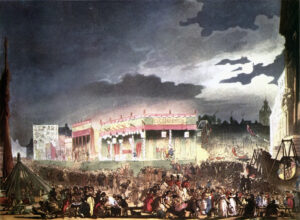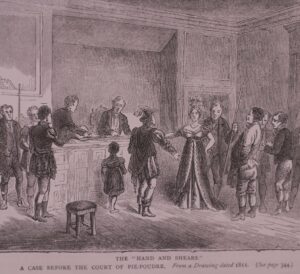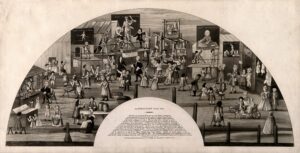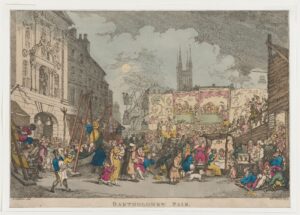Bartholomew Fair is back! The once notorious City of London carnival last seen in 1855 is being re-imagined this September, with over 30 events scheduled to pop up in various locations around the city, featuring live performances and unique spectacles. Highlights include the world-premiere of RESURGAM, a stunning vertical dance performance on St Paul’s Cathedral, and DINNER FOR ALL, a major immersive theatrical circus experience. There’s also the MIDNIGHT RUN, a night-time cultural journey through urban spaces, gathering strangers and local artists together to explore, play and create, whilst the city sleeps. And all that’s just for starters. So how does all this compare to the Bartholomew Fair of old? The story of the infamous annual jamboree goes right back to the 12th century where its beginnings were all very worthy and businesslike.
The origins of Bartholomew Fair
Established by Royal Charter from Henry l, Bartholomew Fair began in 1133 as a trade fair for cloth merchants countrywide. Its purpose was to raise funds for the Priory of St Bartholomew the Great in Smithfield. Held within the grounds of the priory it began as a three-day event coinciding with the Feast of St Bartholomew on 24th August. But the added attraction of sideshows, which ballooned up alongside attracted greater crowds and eventually became the main event. Over time its duration extended to two weeks, and by 1377 the fair had increased so much in size that it overflowed the monastic precincts into neighbouring Smithfield.

By the 16th and 17th centuries the event had grown into a sprawling spectacle of sights and sounds, alive with the vibrant chaos of market stalls, games of chance, puppet shows, jugglers, musicians, and acrobats. One of the unique aspects of Bartholomew Fair was its ability to appeal to people from all walks of life – nobles, artisans, merchants and the lower classes – a veritable tableau of London life with visitors greeted by the intoxicating aromas of roast pork, hot pies, nuts and gingerbread.

Visitors to the fair who felt they’d been the victim of a dodgy deal regarding weights measures or quality could take their grievance to the Hand and Shears pub in Cloth Fair where the Court of Pie Powders (derived from the French pieds poudreaux, dusty feet of travellers) sat for the duration of the Fair. This court was a feature of a fairs up and down the country and promised a swift judgement (before the offending vendor disappeared!).
Bartholomew Fair, the Theatre and Petty Crime
Bartholomew Fair is perhaps most famous for its links with the theatre, and theatrical booths were a popular attraction at the fair in the 18th century. This was the great age of theatre in London. Even in licenced theatres of Drury Lane and Haymarket audiences were raucous and it was not unusual to spice up an opera with wire walkers, performing dogs and other sideshow attractions. So, as the theatres took their late summer break, the actors and writers of Drury Lane (even renowned theatre manager Colley Cibber) were happy to tout their talents in the Smithfield booths.

The City Authorities however dreaded Bartholomew Fair. Held outside of its immediate jurisdiction in the ‘Liberties’ it was a magnet for all sorts of idle, vicious, loose, and debauched people, and endless opportunities for pickpockets, cutpurses and coney catchers (prostitutes could be found in a tent labelled Soiled Doves). The fair is said to have initiated more youths into villainy than Newgate Prison itself, and in 1802 a gang known as Lady Holland’s Mob dispensed with the subtleties of pilfering and pickpocketing by rampaging through the fair ground viciously beating fairgoers with bludgeons and tearing the clothes from women’s backs.

All Good Things Come to an End
Following the suppression of the Monasteries in the 1530s, both the Priory and Bartholomew Fair had been purchased by one of Henry VIII’s ‘fat cats’, the lawyer and statesman Richard Rich, so it was another 300 years before the City Corporation gained full control of the fair, after which rents were raised on stalls, and theatrical booths were ultimately banned in a bid to curtail the worst excesses.
By the 1830s though the fair’s popularity was already waning, as tastes in entertainment were changing, for example the rise of Music Hall, which was diverting audiences to new venues. Bartholomew Fair finally ground to a halt in 1855. It has been celebrated by writers and dramatists from Shakespeare and Ben Jonson to William Wordsworth, who in his poem The Prelude described it as a ‘parliament of monsters’. Re-imagined in 2023 it promises to be rather more marvellous than monstrous, although if there’s one attraction from the past I would choose to revive, it would be the Victorian glassblower, who – wearing a glass wig with tiny glass curls tinkling about his head – would blow you a teacup for threepence.
Enjoy!
Bartholomew Fair runs from 31st August – 16th September
https://www.thecityofldn.com/bartholomew-fair/
Why not find out more about Bartholomew Fair, Smithfield and St Barthlomew the Great by joining our Order and Disorder walking tour.
